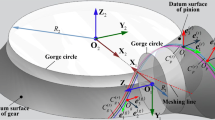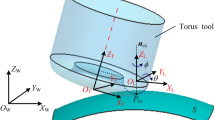Abstract
In this paper, an attempt to develop a new adaptive method of controlling the axis orientation of a toroidal milling cutter (leading angle α) depending on the radius of curvature (radius ρ1 in the feed direction, i.e. on a curved contour) of the treated surface profile in a 5-axis milling process was made. An application of this method required the development, based on the results of simulation and experimental tests (own tests), of a special procedure for selection of the lead angle α of the milling cutter depending on the continuously changing radius of curvature ρ1 in the direction of the milling cutter. This procedure was implemented in a commercial CAM system, thus modifying the classical strategy of controlling the movement of the tool into an adaptive strategy. The proposed method after entering the criterion of the permissible value of the deviation of shape Δk and limiting the permissible parameter Ra of the surface roughness, allows adapting the lead angle α of the toroidal axis to the current value of the radius of curvature ρ1 of the processed composite surface profile. By conducting experimental research on the example of the blade machining of the turbine blade, it was shown that the concept of a new method of controlling the axis of the toroidal milling axis allows the parameters of the lead angle and radius of curvature (α, ρ1) to increase the accuracy of the 5-axis surface treatment of complex elements with contours curvilinear by about 25 %.
Similar content being viewed by others
References
M. Gdula, J. Burek, Ł. Żyłka and M. Płodzień, Five-axis milling of sculptured surfaces of the turbine blade, Aircraft Engineering and Aerospace Technology, 90 (1) (2018) 146–157.
P. Gilles, F. Monies and R. Walter, Optimum orientation of a torus milling cutter: method to balance the transversal cutting force, International Journal of Machine Tools and Manufacture, 47 (15) (2007) 2263–2272.
Y. He and Z. Chen, Optimising tool positioning for achieving ulti-point contact based on symmetrical error distribution curve in sculptured surface machining, The International Journal of Advanced Manufacturing Technology, 73 (5/8) (2014) 707–714.
C. K. Toh, Cutter path orientations when high-speed finish milling inclined hardened steel, International Journal of Advanced Manufacturing Technology, 27 (5–6) (2006) 473–480.
E. A. Gani, J. P. Kruth, P. Vanherck and B. Lauwres, A geometrical model of the cut in five-axis milling accounting for the influence of tool orientation, The International Journal of Advanced Manufacturing Technology, 13 (10) (1997) 677–684.
X. Chen et al., Effects of inclination angles on geometrical features of machined surface in five-axis milling, International Journal of Advanced manufacturing Technology, 65 (9–12) (2013) 1721–1733.
T. J. Ko, H. S. Kim and S. S. Lee, Selection of the machining inclination angle in high-speed ball end milling, International Journal of Advanced Manufacturing Technology, 17 (2001) 163–170.
M. Sadilek, R. Cep and M. Sokovic, Aspects of using tool axis inclination angle, Journal of Mechanical Engineering, 57 (9) (2011) 681–688.
M. Fu, M. Zheng and Z. Yang, Research of surface roughness in high-speed ball-end milling Al-alloy, Journal of Harbin University of Science and Technology, 9 (3) (2004) 4–7.
W. Lan, Research of Inclination angle of high-speed ballend cutter, Machinery and Manufacture, 11 (2010) 152–153.
Y. Quinsat, S. Lavernhe and C. Lartigue, Characterization of 3D surface topography in 5-axis milling, Wear, 271 (2011) 590–595.
T.-S. Lim, C.-M. Lee, S.-W. Kim and D.-W. Lee, Evaluation of cutter orientations in 5-axis high speed milling of turbine blade, Journal of Material Processing Technology, 130/131 (2002) 401–406.
G. M. Kim, B. H. Kim and C. N. Chu, Estimation of cutter deflection and form error in ball-end milling process, International Journal of Machine Tools and Manufacturing, 43 (9) (2003) 917–924.
E. T. Christophe, Iso-scallop tool path generation in 5-axis milling, International Journal of Manufacturing Technology, 25 (9–10) (2005) 867–875.
M. Fontaine, A. Moufki, A. Devillez and D. Dudzinski, Modelling of cutting forces in ball-end milling with toolsurface inclination: Part I: Predictive force model and experimental validation, Journal Material Process Technology, 189 (1–3) (2007) 73–84.
L. N. Lacalle, A. Lamikiz, J. A. Sanchez and M. A. Saldago, Toolpath selection based on the minimum deflection cutting forces in the programming of complex surfaces milling, International Journal of Machine Tools and Manufacture, 47 (2) (2007) 388–400.
Q. Y. Cao, D. Y. Xue, J. Zhao and Y. E. Li, A cutting force model considering influence of radius of curvature for sculptured surface machining, International Advanced Manufacturing Technology, 54 (5–8) (2011) 821–835.
F. Klocke, M. Brumm and J. Staudt, Quality and surface of gears manufactured by free-form milling with standard tools, GearTechnology, 1–2 (2015) 64–69.
M. Kaymakci and I. Lazoglu, Tool path selection strategies for complex sculptured surface machining, Machining Science and Technology, 12 (1) (2008) 119–132.
A. Lasemi, D. Y. Xue and P. H. Gu, Tool path re-planning in free-form Surface machining for compensation of process-related errors, International Journal Production Research, 52 (20) (2008) 5913–5931.
Q. Y. Cao, J. Zhao and L. Zhu, The effect of curvature radius of sculptured surface on finish milling tool path selection, International Journal Advanced Manufacturing Technology, 89 (2017) 3349–3357.
M. Zander, Potentiale beim Mehrachsen-Frasen mit Toruswerkzeugen im Formenbau, Dissertation RWTH Aachen (1995).
S. Altmuller, Simultanes funfachsiges Frasen von Freiform flachen aus Titan, Dissertation RWTH Aachen (2001).
J. Redonnet, S. Djebali, S. Segonds, J. Senatore and W. Rubio, Study of the effective cutter radius for end milling of free-form surfaces using a torus milling cutter, Computer Aided Design, 45 (6) (2013) 951–962.
Author information
Authors and Affiliations
Corresponding author
Additional information
Recommended by Associate Editor Yongho Jeon
Michał Gdula, Ph.D., Eng., works in the Department of Manufacturing Technology and Automation at the Faculty of Mechanical Engineering and Aeronautics of the Ignacy Łukasiewicz Rzeszow University of Technology. He specializes in the issues related to computer CAD/CAM techniques in the manufacture of products, especially in 5-axis machining of sculptures surfaces.
Rights and permissions
About this article
Cite this article
Gdula, M. Adaptive method of 5-axis milling of sculptured surfaces elements with a curved line contour. J Mech Sci Technol 33, 2863–2872 (2019). https://doi.org/10.1007/s12206-019-0534-4
Received:
Revised:
Accepted:
Published:
Issue Date:
DOI: https://doi.org/10.1007/s12206-019-0534-4




